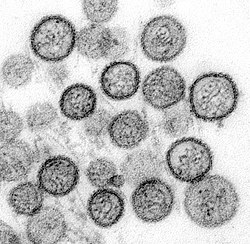
Hantavirus hemorrhagic fever with renal syndrome (HFRS) is a group of clinically similar illnesses caused by species of hantaviruses. It is also known as Korean hemorrhagic fever and epidemic hemorrhagic fever. It is found in Europe, Asia, and Africa.[1] The species that cause HFRS include Hantaan orthohantavirus, Dobrava-Belgrade orthohantavirus, Saaremaa virus, Seoul orthohantavirus, Puumala orthohantavirus and other orthohantaviruses. Of these species, Hantaan River virus and Dobrava-Belgrade virus cause the most severe form of the syndrome and have the highest morbidity rates. When caused by the Puumala virus, it is also called nephropathia epidemica. This infection is known as sorkfeber (vole fever) in Swedish, myyräkuume (vole fever) in Finnish, and musepest (mouse plague) in Norwegian.
Both HFRS and hantavirus pulmonary syndrome (HPS) are caused by hantaviruses, specifically when humans inhale aerosolized excrements of infected rodents. Both diseases appear to be immunopathologic, and inflammatory mediators are important in causing the clinical manifestations.[2]
- ^ Cosgriff TM, Lewis RM (December 1991). "Mechanisms of disease in hemorrhagic fever with renal syndrome". Kidney Int. Suppl. 35: S72–9. PMID 1685203.
- ^ Peters, Md; Simpson, Md, Phd, Mph, Gary L.; Levy, Md, Phd, H. (1999). "Spectrum of Hantavirus Infection: Hemorrhagic Fever with Renal Syndrome and Hantavirus Pulmonary Syndrome1". Annual Review of Medicine. 50: 531–545. doi:10.1146/annurev.med.50.1.531. PMID 10073292.
{{cite journal}}: CS1 maint: multiple names: authors list (link)